How to Maintain Your Personal Brand on LinkedIn
There are plenty of benefits to creating a personal brand on LinkedIn, including:
- More opportunities to be scouted by recruiters with better offers (or at least leverage to ask for a raise)
- Build relationships with other industry experts
- Receive exclusive invitations to special events
However, only a small percentage of people build strong personal brands.
Why?
There seems to be a misconception that building a strong personal brand is hard – even impossible if you don't have an impressive background.
While building a strong personal brand certainly doesn't happen overnight, it's far from impossible. It really comes down to optimizing your LinkedIn profile, creating high-quality content consistently, and engaging with other people's posts.
So in this post, we'll outline the exact process you can use to build a strong personal brand and reap the corresponding benefits.
Step 1: Add a Profile Photo and a Banner Image
Your headshot is your first impression, so make sure you have a professional headshot that's in focus with good lighting.
However, don't feel you must wear a suit and tie. If you're more playful and fun, wear something that reflects your personality.
In fact, lean into your personality and create a unique brand identity. Below you can see how Noah Kagan and Justin Welsh have very different yet well-defined personalities:
.png?width=762&height=548&name=Personal%20Brand%20on%20LinkedIn%20-%20Noah%20Kagan%20Profile%20(fun).png)
.png?width=762&height=622&name=Personal%20Brand%20on%20LinkedIn%20-%20Justin%20Welsh%20Profile%20(serious).png) If you’re stuck while crafting your cover photo, here are a few ideas:
If you’re stuck while crafting your cover photo, here are a few ideas:
- Create a CTA to an offer you’ve created
- Show off a personal motto
- Show off accomplishments or your core skill set
One thing worth noting is that your banner image should ideally match the same style as your headshot. You’ll notice that in the two examples above, the headshots and banner images use similar colors and styles.
Step 2: Creating a Compelling Bio and Title
The next step is to create a compelling title and biography/description.
Starting with the title, you can take this in a few different directions. If you're looking for a new job, it's best to use a traditional job title (e.g., "VP of Marketing" or "SEO Manager") so that recruiters can find you easily when they're searching for candidates.
However, if you're an entrepreneur looking to connect with a specific audience, include that in your profile title. For example, Justin Welsh states exactly who he is looking to connect with:
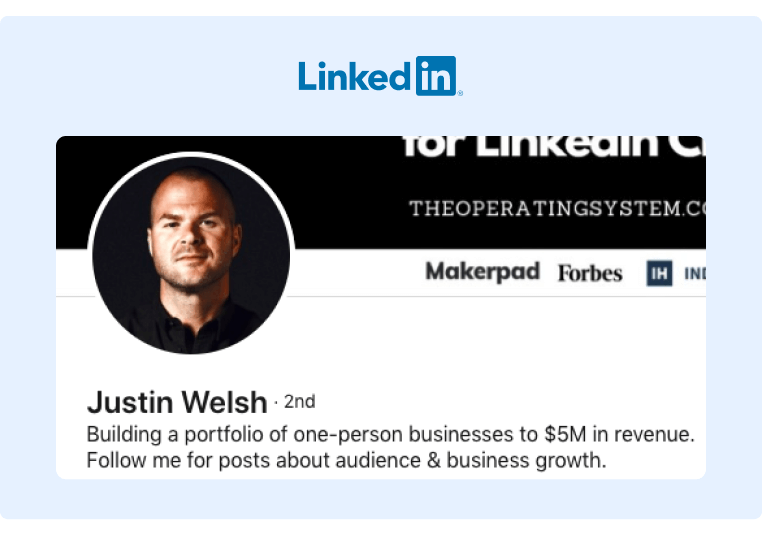
Another option is to state your title and then a core belief that you live by. Lloyed Lobo’s LinkedIn profile is an excellent example of this:
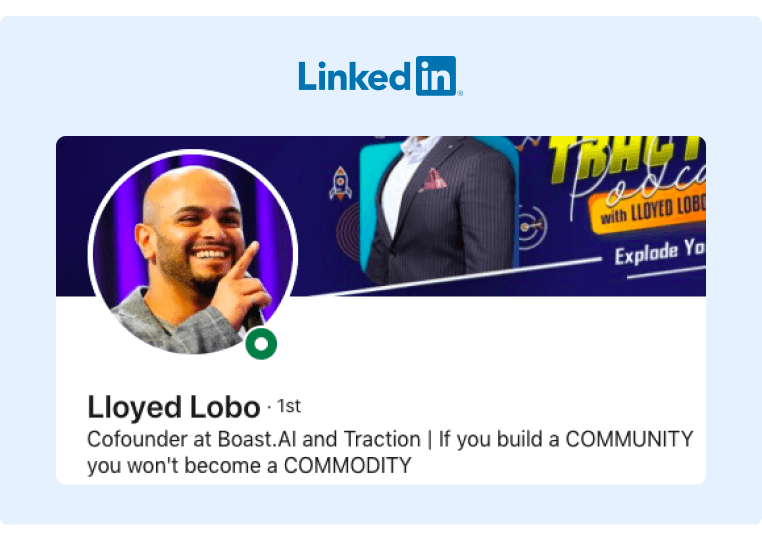
The About section is another place where you have some freedom to play around with different writing styles.
Some people use this space to list their accomplishments, like this one by Andy Crestodina:
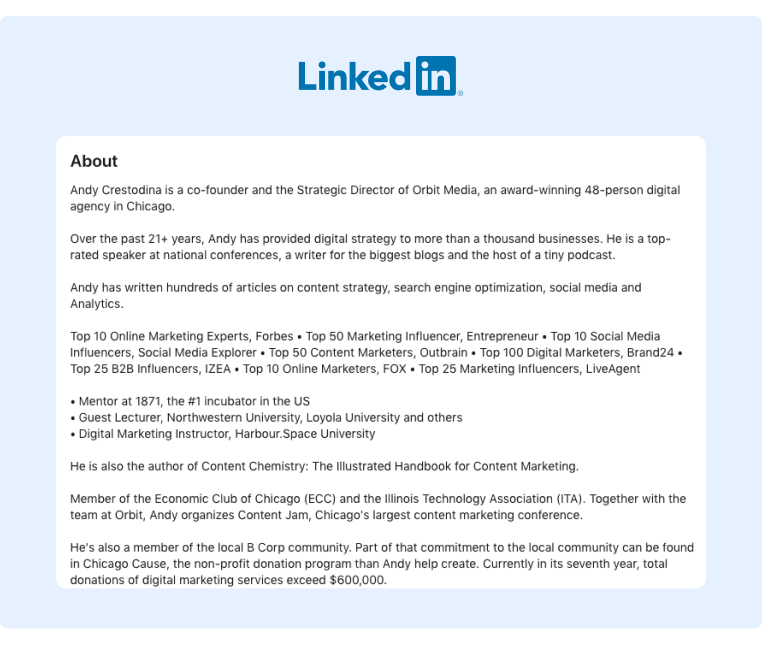
However, you can also use this as an opportunity to tell a story about yourself and communicate your core beliefs.
Here’s an excellent example of a story-focused About section:
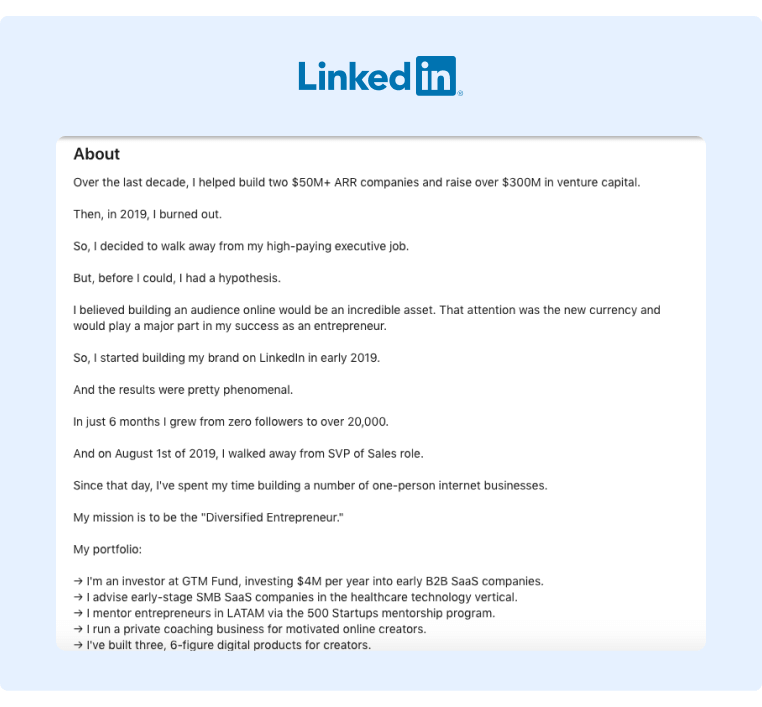
Step 3: Including Experience, Skills, and Education
As you fill out your LinkedIn profile, think about your core skills and optimize the entire profile to reflect only those skills.
Therefore, only include experiences and skills relevant to your core skills.
As you write about your experiences, include specific metrics, awards, and other relevant accomplishments. Here's an excellent example of a well-optimized experience page:
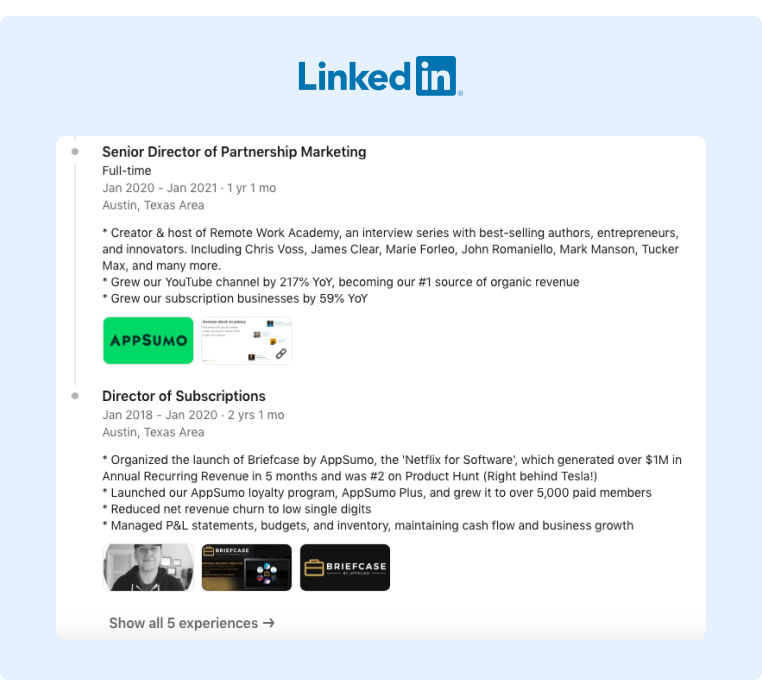
It's also important to include any promotions as many recruiters look to hire people that have been promoted (ideally multiple times in a short time period).
The next step is to add skills in the experience section and then reach out to colleagues in your LinkedIn network for endorsements.
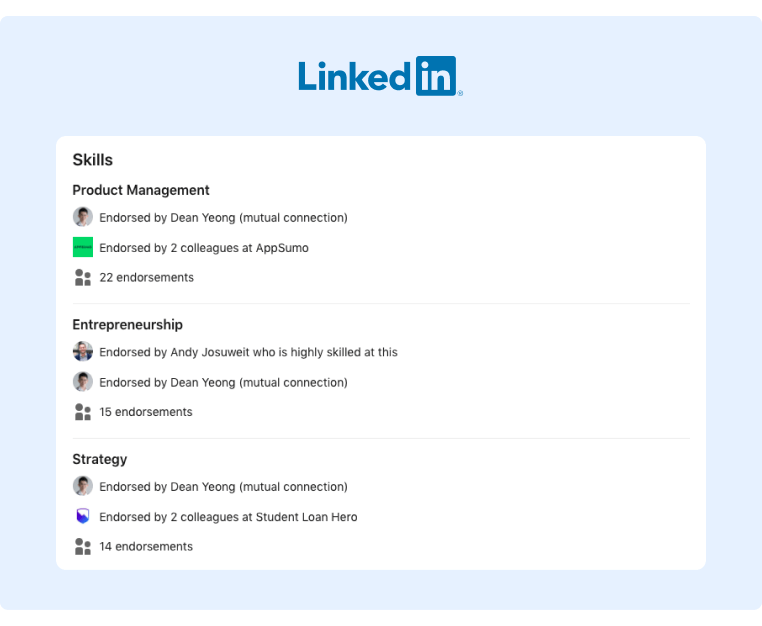
If you feel awkward about asking others to endorse your skills, here’s a simple message you can send:
“Hi (name), I’m working on upgrading my LinkedIn profile and just added some new skills. It still looks a little bare, so I was wondering if you would consider endorsing some of them? If you get 30 seconds, here’s the link to do so. Feel free to send me your link and I’d be happy to endorse you as well! Thanks!”
Step 4: Create High-Value Content
Now you have a well-optimized personal profile, though unfortunately, nobody will find it or have any incentive to connect with you if you aren't actively posting content.
This is where a lot of people give up.
The reality is that your posts probably won't generate much traction for the first several months. However, it's still important to post consistently and grind it out for those first few months to gain some initial traction and improve your content marketing skills.
You'll also figure out what kind of content your audience likes and can produce more of that style.
To help you get started with your LinkedIn content strategy, here are a few tips.
First, people prefer to consume content that illustrates someone's personal experience rather than content that preaches a concept.
This is a key principle that Alex Hormozi lives by, and he used it to grow his LinkedIn following from zero to 30,000 plus followers in less than a year. The caveat is that he had done some pretty impressive things, like building and selling multiple eight-figure businesses, before ever trying to build a LinkedIn following.
So what can you do if you haven't done something impressive like selling a multi-million dollar business?
First, record even small discoveries that you've made. Here's a great example:
If you're really at a loss, you can interview people who have done impressive things and ask if you can write a LinkedIn post about their experience (and obviously give them credit).
Even though it's not your personal experience, people will still follow you and send a connection request if you consistently deliver high-quality content. As an added benefit, this is also a great tactic for building relationships, as people love shout-outs.
You can also turn it into thought leadership content by adding your own commentary to the case study.
Here's a great example of a writer that analyzed the growth of a random website and then added his own thoughts to it:
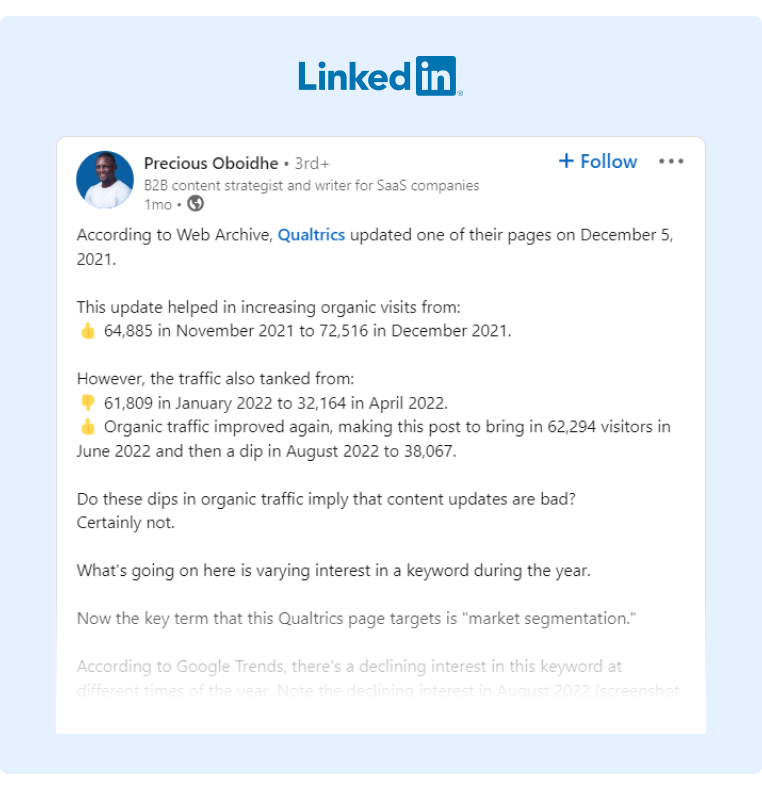
Step 5: Engage With Influencers and Connections
Finally, engage with LinkedIn influencers who your target audience follows. The idea is that, over time, you can develop a meaningful connection with these influencers, which can lead to various opportunities like:
- Content collaborations
- Introductions to potential clients
- New job opportunities
- Speaking opportunities
- Lifelong friendships
So how do you go about building meaningful relationships on social media?
First, select a handful of influencers (say, ten people) who you genuinely want to connect with that have less than 10,000 followers.
If you select a mega influencer, they probably won't even realize if you're consistently engaging with their content, so niche down to find a micro-influencer you admire.
From there, consistently share content they publish with your professional network and leave thoughtful comments on their posts.
Over time, they will notice that you're an avid fan and (assuming your comments are interesting) will likely be open to building a deeper relationship with you.
By creating real relationships with these people, your social network will grow, and you'll likely become a thought leader yourself.
Examples of Excellent Personal Brands
Here are some examples of excellent personal brands on LinkedIn to give you some inspiration. Each of them has a long list of impressive accomplishments to their name, which certainly makes it easier to grow a personal brand. However, I'll also show you a few specific things they do very well that you can steal.
1. Tim Soulo
Tim Soulo is the CMO of Ahrefs and a popular influencer in the SEO industry. I included him on this list as he's an excellent example of an employee who does an excellent job of leveraging his company (Ahrefs) to help him grow his personal brand.
He consistently Tweets about thought-provoking topics related to the company's tool and doesn't shy away from controversial topics:
If your brand doesn’t feel comfortable about surfacing objections, you can still take a controversial stance on any topic. Here’s a great example where Tim discusses why you should not try to measure the ROI of your content marketing strategy:
Let's talk about the "ROI of Content Marketing."
— Tim Soulo 🇺🇦 (@timsoulo) March 23, 2021
Far too often us marketers get challenged with this question by our boss (or our client):
- How do I know that my investment in content will guarantee a positive return? ...& how can I MEASURE it?
[Read more..]
2. Rand Fishkin
Rand Fishkin is the founder of SparkToro and first became an influencer as the founder of the SEO tool Moz. Most of the content he produces explains a marketing hack and how you can use his tool, SparkToro, to accomplish it.
However, the marketing hacks are very original, and it's valuable to listen even if you don't purchase his tool. Here's a great example with his video about the Parable of the Pizzeria.
I mentioned earlier that most people coming to social media don't really want strictly educational content, though Rand's educational (and product-focused) content does very well for a few reasons:
-
The ideas are genuinely original and unique. So it's entertaining to listen to, even if you aren't actively searching for a marketing hack.
-
The posts themselves are well-optimized for social media because all of his videos (which is his primary content format) include an image of him which adds a humanistic feel. The other half of the screen is also well produced and optimized to hold the reader's attention.
-
He built much of his personal brand at Moz on the backs of Whiteboard Friday, an educational series where Rand taught others about SEO in snackable 10-minute clips. This carried well through his career to SparkToro.
Finally, Rand always interacts with other people's content and responds to comments, which makes him seem human and approachable.
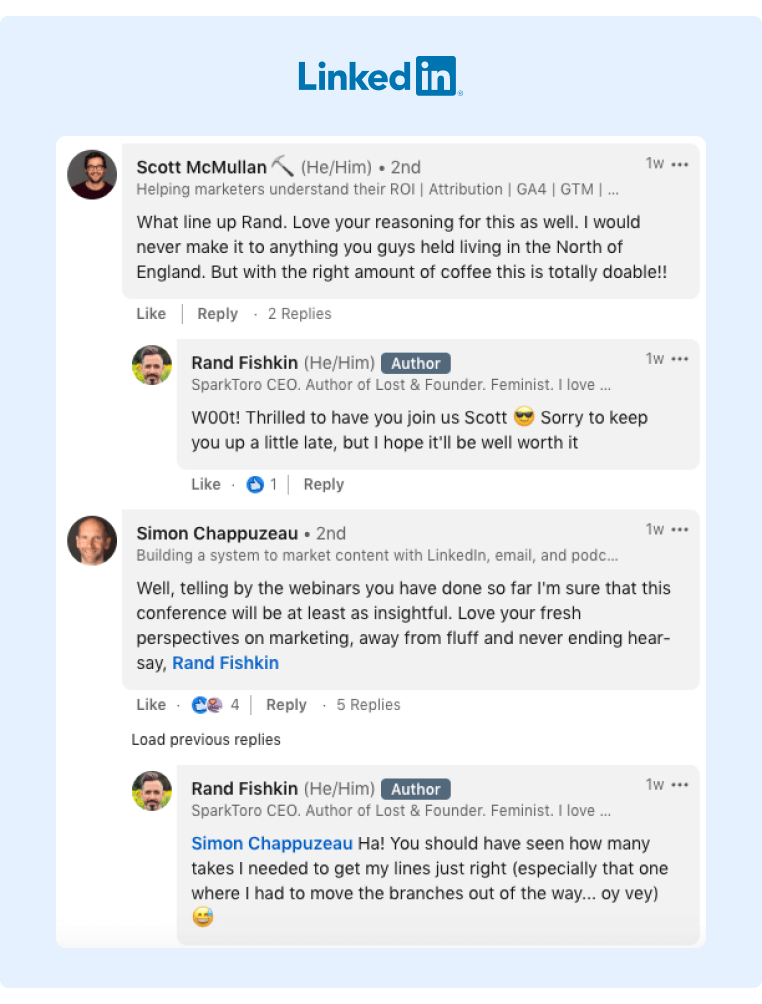
3. Shaan Puri
Shaan Puri is a successful investor and co-host of the popular podcast, My First Million.
Unlike the other influencers mentioned above, he focuses less on tactics and more on sharing his own ideas about startups and building businesses.
He also repurposes a lot of ideas mentioned on his podcast, which makes it easy for him to consistently pump out a high volume of quality content. For example, a lot of his posts are about business ideas mentioned on the podcast, like this one about Reese Witherspoon's production company:
He also has a great sense of humor, making him enjoyable to follow. You can tell this even just by looking at his bio:
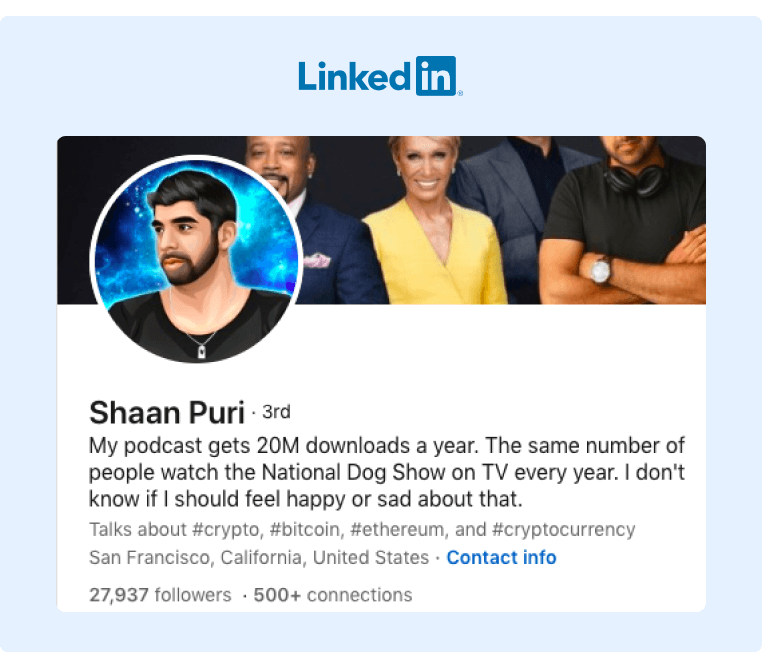
So even if you’re working with a B2B audience, incorporate humor into your posts.
4. Brendan Hufford
Brendan Hufford runs his own marketing agency, Growth Sprints, and is primarily active on LinkedIn.
His bio says that he is "Exploring what works in SaaS marketing and sharing it along the way." When you look at the posts he publishes you can see that this is his exact content strategy.
Here's a great example:
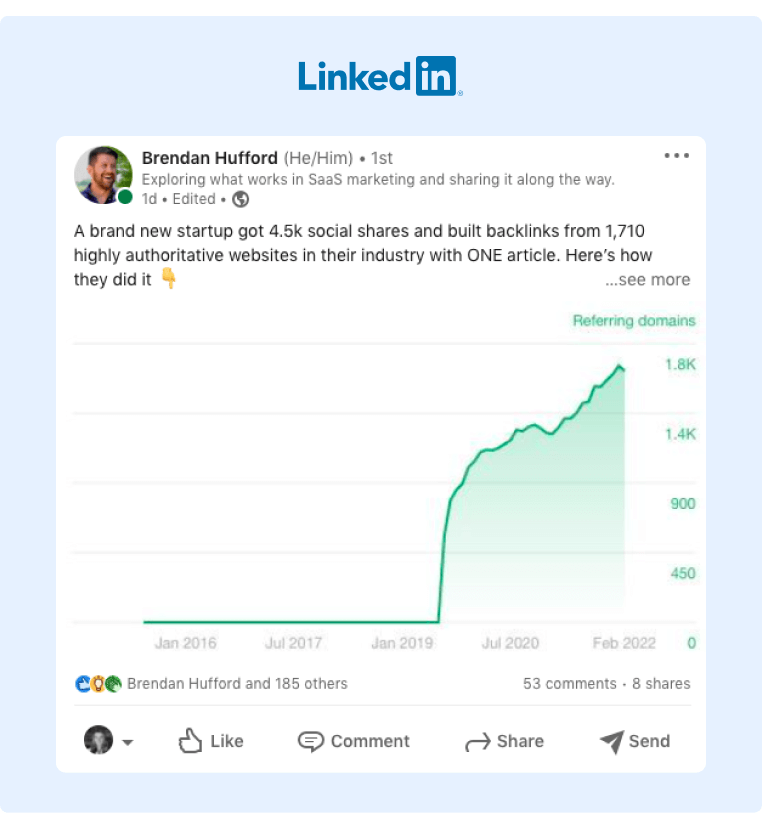
He also takes a contrarian/outspoken approach in much of his content. So rather than repeating the same "best practice" advice, he breaks down why it doesn't work and what people should do instead.
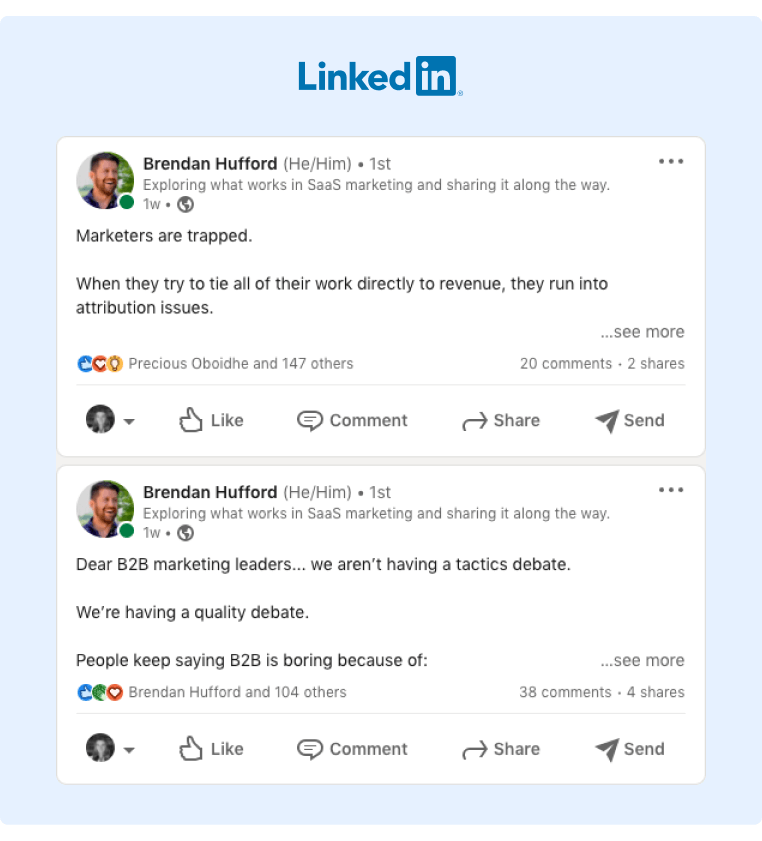
Finally, he’s very consistent and active in the comments. In other words, he’s social on social media.
Start Building Your Personal Brand on LinkedIn Today
Building a strong personal brand on LinkedIn is an unfair advantage as you’ll be able to attract job offers, collaborations, and other opportunities to further your career.
While building a strong following doesn’t happen overnight, you’d be surprised how steadily posting interesting ideas and experiences can open you up to a new world of opportunities.
If you’re a marketing manager helping your employees build their personal brands to boost brand initiatives, you can use an employee advocacy tool like GaggleAMP to supercharge their growth.










